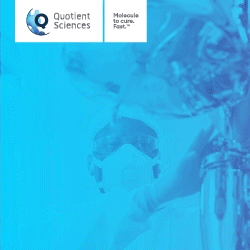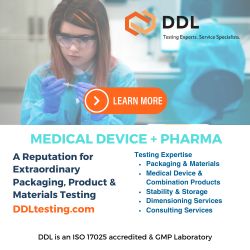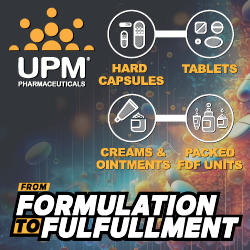Issue:Respiratory e-Book 2022
2022 Respiratory Drug Development eBook - Demand Accelerates Devices
The pulmonary/respiratory drug delivery market was valued at $53 billion in 2021 and is expected to reach $87 billion by 2029. COVID-19, asthma, and surging cases of chronic obstructive pulmonary disease (COPD), the third greatest cause of death globally, with an average of 3 million deaths annually, will foster the demand for pulmonary/respiratory drug delivery.1
According to Nemera, global recommendations for managing COPD highlight the importance of ensuring patients adhere to a prescribed dosing regimen. “To design and develop a user-friendly and high-performing device that answers patients’ and technical needs, the only viable solution is to develop the device with the patients, from the early-stage phase to the final steps of validation,” says Mark Tunkel, Global Category Director, Services, at Nemera.
Pulmonary/respiratory drug delivery is often preferred broadly because of the non-invasive approach, high blood circulation, big surface area for absorption, and permeability rate. Furthermore, the benefits associated with the pulmonary/respiratory drug delivery system, such as the large surface area present in alveolar sacs, high drug loading efficiency, and high vascularization that makes lung an appropriate site for drug absorption, are expected to boost the market’s growth.1
The pulmonary/respiratory drug delivery market is segmented into formulation type and device type. Formulation type is sub-segmented into suspension, aerosol, solution aerosol, and dry powder formulation. Device type is sub-segmented into metered dose inhalers (MDI), dry powder inhalers (DPI), and nebulizers. MDIs contain liquid medication, but DPIs contain powder medication. MDIs include a chemical propellant that pushes liquid medication out of the inhaler as a gas. It works like a spray can. But because the medication comes out as a gas, you have to inhale while you trigger the inhaler. DPIs contain a sealed dose of powder medication, often in a capsule or disk. A DPI pierces the capsule or disk so you can breathe the powder into your lungs. These inhalers are breath-activated, meaning it will only release the medication when you take a deep, fast breath from the inhaler. Pressurized metered-dose inhalers (pMDI) are a type of MDI that works based on the pressurized propellant in the aerosol chamber. pMDIs have started to be considered the inhaler devices that are most commonly prescribed to deliver drug agents to the bronchial tree. The metering valve is considered a crucial component of the pMDI device. The metering valve is the part of the inhaler, which is responsible for delivering the micronized drug contained in a propellant in precise volumes given in each actuation.
For suspension formulations, shaking the pMDI is an essential step to ensure that the aerosol released from the device contains a uniform drug dose. Earlier this year, Proveris Scientific Corporation added the Kinaero Cx™ pMDI Collection System to its product portfolio to automate the pMDI shaking, actuation, and sample collection for delivered dose uniformity (DDU) and aerodynamic particle size distribution (APSD). The Kinaero Cx system offers increased throughput when used alongside the Kinaero pMDI High Throughput Fire-Down System. The Kinaero Fire-Down System precisely automates shaking and actuation to waste of up to 10 devices simultaneously, ensuring uniform dose delivery for every shot when transitioning between the beginning, middle, and end-of-life stages for an inhaler device. Lynn Jordan, Senior Applications Manager at Proveris, explains that there is much potential for automation to reduce the variability associated with inhaler testing.
This fourth annual Drug Development & Delivery Respiratory eBook highlights the pMDI development path, as well as the importance of a holistic approach to that development that includes the patient and all stakeholders across the product’s life cycle.
Reference
1. Global Pulmonary/Respiratory Drug Delivery Market Analysis and Size, Data Bridge Market Research, March 24, 2022.
 Nemera’s Approach to Holistic Management of a Combination Product: An Increasingly Complex Landscape
Nemera’s Approach to Holistic Management of a Combination Product: An Increasingly Complex Landscape
By: Mark Tunkel, Global Category Director, Services at Nemera
The complexities involved in selecting or developing the correct device for a combination product have never been more challenging. A convergence of trends, including significant growth in the global drug development pipeline, the need for more complex delivery devices to address targeted applications and drug attributes, and increased migration of care from clinical to self-administration in home settings have driven demand for a wide range of solutions. This is coupled with a crowded competitive landscape in the biologics, biosimilars, and generics segments, in which multiple competitors may be pursuing the same applications. Pharma companies are under increased pressure to drive patient centricity, increase speed to market, reduce their risk, and create value for patients and other stakeholders across the landscape. Beyond the patient, this includes an ecosystem of stakeholders including providers, namely healthcare professionals, but also health systems – payers – to consider factors such as value-based care, and regulators, as the market for product introduction and the intended filing approach can impact device selection and development strategies. These factors lead to a need for a holistic approach to developing a device strategy and better decision making across the life cycle of drug products.
Integrating the Voice of the Patient Into Development
At the earliest stages of establishing the functional requirements and user needs for a new device application, it is critical to fully understand the patient journey and related clinical processes. Our design research team utilizes “applied ethnography” to achieve this goal. This relies on interviews and in-context observations of practices, processes, and experiences within the patient’s use environment, beyond the administration event or complying with instructions for use. This starts when a patient is diagnosed, receives their device, and goes through the entire process of preparing, administering, disposing, and all the times in between treatment, to understand how the process changes over time and how frequency of administration impacts the patient experience. It is equally important to gain an understanding of the experience of healthcare professionals to consider relevant settings in clinical environments.
The outputs of applied ethnography include patient journey maps, clinical process maps, an understanding of prioritized user needs and values, and pain points that can be leveraged toward improving the patient and provider experience. This supports meeting needs holistically while making decisions around assessing the technology landscape to identify existing IP or platforms that may be fit for the intended purposes related to function and drug product attributes.
Surrounding the Device for Safe, Effective & Differentiated Combination Products
Once a technology or development project has been initiated, its human factors and patient experience activities must be integrated to ensure an efficient development process. The selected device, in combination with the drug, is appropriate, safe, and effective for the target population. This also extends to optimizing the patient experience to create competitive differentiation and to ensure adherence and engagement with patients and clinical stakeholders. Developers need to be sure that they are addressing the defined user group populations and early use-related risk analysis activities to define the human factors and usability program. Clinical risks must be identified through conducting formative and summative usability testing for all aspects of the device and supporting assets in alignment with the human factors program definition, including the production of human factors engineering report documentation for use in for regulatory submissions. This process is linked to developing instructions for use, value-added packaging, as well as leveraging digital health-related add-ons to support patient engagement/adherence and value the platform. This can also be augmented by fit-for-purpose pre- clinical, clinical, and small series device supply to accelerate development timelines and defer capital expenses.
Benefits of Partnering With an Integrated Service Provider
Successful navigation of these challenges often times requires a partner with a broad set of capabilities and services. Nemera’s integrated contract development, consulting, and manufacturing services allows customers to achieve the outcome of a successful regulatory submission and commercial launch of safe, effective, and differentiated combination products with a single partner applying an agile process across the device and combination product value chain. This provides customers the benefit of patient centricity and engagement, innovation that is consistently executed across the journey, and reduction of risk and increased speed of market access for both customer organic development and utilization of IP platforms.
 Helping pMDI Drug Developers to Efficiently Produce Consistent High-Quality Data & Meet Complex Regulatory Requirements
Helping pMDI Drug Developers to Efficiently Produce Consistent High-Quality Data & Meet Complex Regulatory Requirements
By: Lynn Jordan, Senior Applications Manager, Proveris Scientific
Pressurized metered dose inhalers (pMDIs) are a class of combination drug products that are dependent on the optimization of a formulation, device design, and human usage to deliver an accurate, reproducible dose. In the case of pMDI suspension products, the shaking profile is crucial for accurate dose delivery. Lack of appropriate shaking can deliver a high amount of the drug in the early doses followed by very little or no drug towards the end of product life. Other important influencing factors on pMDI performance include force-to-actuate and hold time to ensure that the metering valve is open long enough to deliver a complete dose. A minimal shake-to-fire delay is another crucial factor for maintaining the uniformity of the delivered dose.1
Testing Strategies & Solutions for pMDI Devices
Proveris by Design™: Based on the Quality by Design (QbD) approach endorsed by the U.S. FDA, Proveris by Design provides the basis of experiments to first identify the range of human usage parameters of a pMDI according to current regulatory guidelines for in vitro testing. Next, it offers strategies to test the range of design spaces and gain an understanding of the control space: Which of these factors has the most impact on product performance? Lastly, it identifies the target operating space and control for key influencing factors in a tight range during the in vitro testing. One of the deliverables of the approach is a sensitivity map based on the design of experiments, which shows how much influence factors identified in the design space have on the overall performance of the product.2 In the R&D phase, clients engage Proveris Laboratories to perform tests using this method to efficiently produce consistent high quality data during product development and for preparation of regulatory submissions.
Ergo™ Studies: Proveris Laboratories offers human-realistic actuation studies performed using proprietary Ergo technology to accurately quantify how trained testers in the targeted population actuate the product. Client device candidates and/or reference product in the case of generic drug development projects are evaluated to obtain key actuation parameters, such as stroke length, velocity, acceleration, and hold time. This data is fully transferrable to Proveris Scientific Vereo® automated actuators to enable reproducible actuations in a human-realistic way.
Vereo SFMDx Actuators: As with any pharmaceutical product, it is important to perform in vitro tests with repeatable, reproducible, and robust methods for a smoother product development process. Vereo automated actuators provide fully controllable and repeatable actuation for commonly required regulatory tests, controlling up to six critical actuation parameters and four additional parameters related to shaking for pMDI devices. The flexible design allows them to fit seamlessly into multiple testing workflows with identical actuation parameters implemented across all tests, ensuring data integrity and accuracy.3
In vitro tests performed using Vereo SFMDx Actuators:
- Delivered dose uniformity (DDU)
- Single actuation content uniformity (SAC)
- Valve/pump delivery (shot weight)
- Aerodynamic particle size distribution (APSD)
- Droplet size distribution (DSD)
- Spray pattern and plume geometry
- Plume front velocity, spray duration and evaporation fraction
- Priming and repriming
- Product wasting for through life testing
Starting a new pMDI development project can be intimidating. A partner with the right expertise and extensive experience in the field can significantly streamline the development effort. To learn how Proveris Scientific and Proveris Laboratories can be your partners from early development to commercial scaled testing, please visit www.proveris.com/why-proveris or email us at contactus@proveris.com.
References
- Variability in Delivered Dose from Pressurized Metered-Dose Inhaler Formulations Due to a Delay Between Shake and Fire, Hatley RH, Parker J, Pritchard JN, von Hollen D., https://www.ncbi.nlm.nih.gov/pmc/articles/PMC6059354/.
- Proveris by Design™: A Roadmap for In Vitro Characterization of Orally Inhaled and Nasal Drug Products, Liao L., Proveris Scientific White Paper, https://www.proveris.com/proveris-white-papers/#proverisbydesign.
- Complete Solution for pMDI Products: From Development to Quality Control Testing, Chauhan H., Proveris Scientific White Paper, https://www.proveris.com/proveris-white-papers/#solutionsforpmdi.
Total Page Views: 4330














